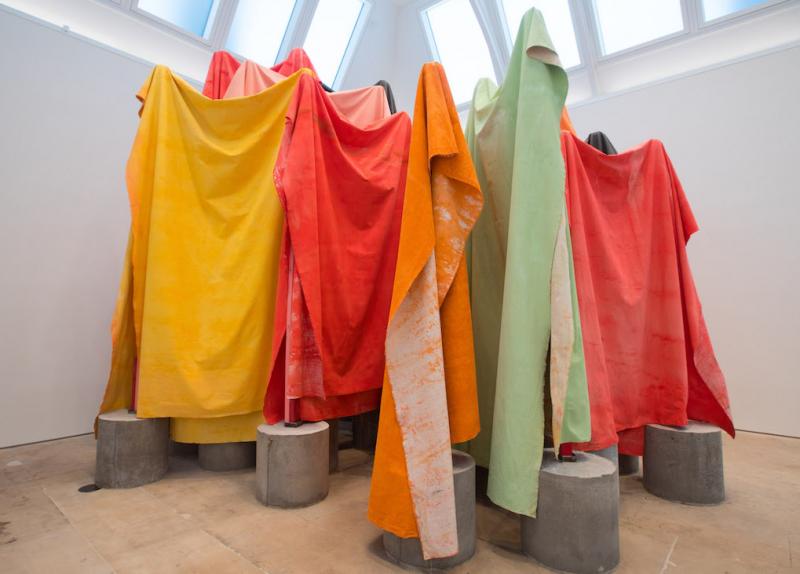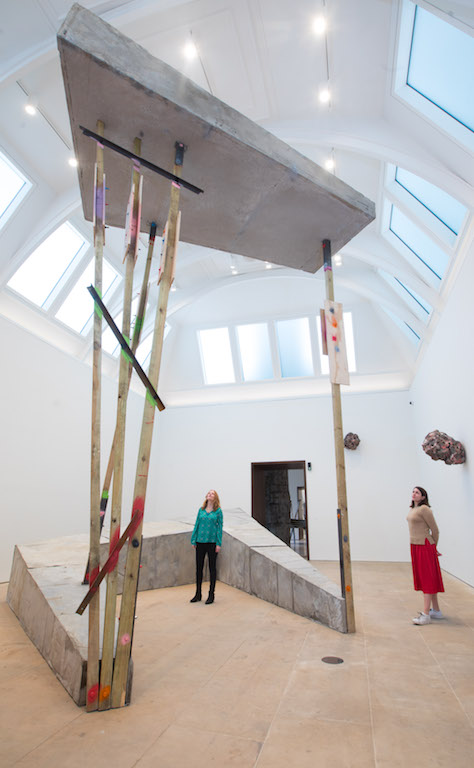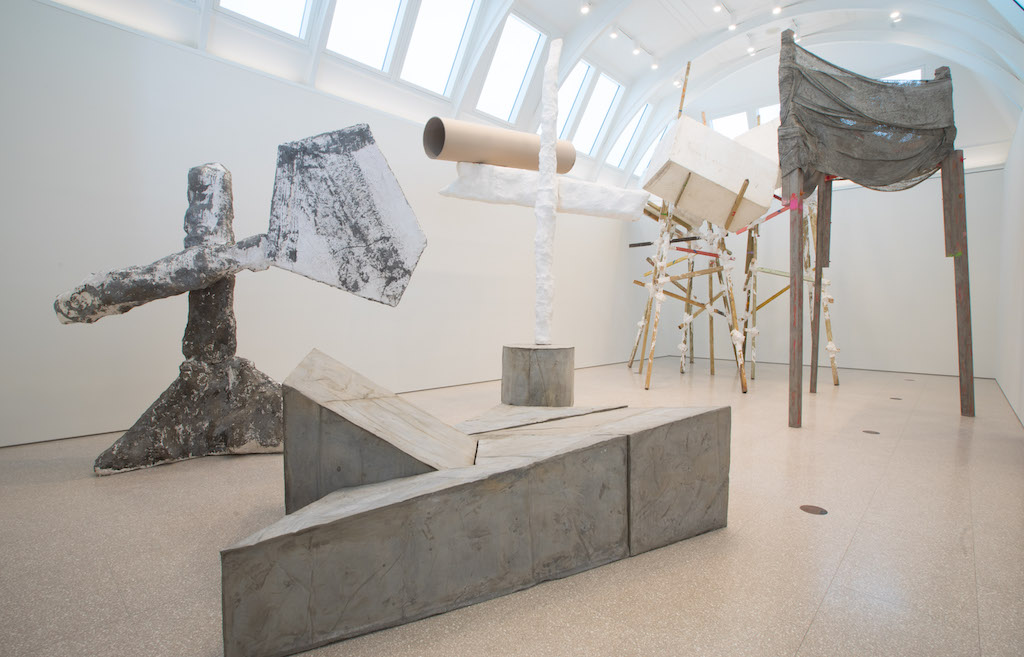Phyllida Barlow: Cul-de-sac, Royal Academy review - unadulterated delight | reviews, news & interviews
Phyllida Barlow: Cul-de-sac, Royal Academy review - unadulterated delight
Phyllida Barlow: Cul-de-sac, Royal Academy review - unadulterated delight
The most inspiring show of the year makes sculpture look easy

It doesn’t get better than this! Phyllida Barlow has transformed the Royal Academy’s Gabrielle Jungels-Winkler Galleries into a euphoric delight. Entering the space, you have to turn right and process through the three galleries; but by closing the end door to create the cul-de-sac of the title, Barlow has turned this somewhat prescriptive lay-out into a theatrical experience.
Greeting you on arrival is a vast portal (pictured below right). Perched precariously on thin wooden stilts, a concrete canopy casts a chunky, wedge-shaped shadow. This magisterial structure is highly paradoxical. Made of inadequate lengths of timber bolted together, the uprights look far too flimsy to support the weight of the canopy while, far from being ethereal and ephemeral, the “shadow” resembles solid stone. Its all smoke and mirrors, of course. What appears to be concrete is actually cement lathered onto scrim that has been stretched over lightweight materials like plywood and polystyrene. The pomposity normally associated with grand entrances is thereby subverted by this unashamedly ad hoc assemblage.
Phyllida Barlow represented Britain at the Venice Biennale in 2017. She filled the neoclassical pavilion to bursting point with pillars, stacks, globules, clumps, crowds and clusters that, often daubed with paint, were like drunken gate crashers boisterously declaring occupancy of the genteel space. Post-Venice, Barlow is now showing slightly more restraint. Here the exhibits are more like discreet entities than an unruly horde, yet their incursion into the R.A’s elegant galleries is no less emphatic.
 Canvasracks (main picture) is the only colourful sculpture on show. A flurry of bright, monochrome canvases thrown over metal supports, it stands in a corner like a group of ghouls solemnly performing a ritual dance. Despite the concrete cylinders anchoring them to the floor, one could swear they were swaying under their gorgeous shrouds and secretly muttering dark incantations.“The work is all about the gesture of throwing canvases over posts,” Barlow explains, “and the heavy feet were an important expedient.”
Canvasracks (main picture) is the only colourful sculpture on show. A flurry of bright, monochrome canvases thrown over metal supports, it stands in a corner like a group of ghouls solemnly performing a ritual dance. Despite the concrete cylinders anchoring them to the floor, one could swear they were swaying under their gorgeous shrouds and secretly muttering dark incantations.“The work is all about the gesture of throwing canvases over posts,” Barlow explains, “and the heavy feet were an important expedient.”
Despite being predominantly grey and white, the other sculptures are no less dramatic. Barlow emphasises the low ceiling in the central space by installing a floor-to-ceiling pillar that is incongruously stocky for its height. It casts a crescent-shaped shadow made of honeycomb layers impaled on multiple wooden poles, like a giant waffle stuck with myriad toothpicks. While the column provides an axis that stabilises the rest of the exhibition, this room feels like a transitional space leading through to the main event.
The end gallery plays host to four sculptures (pictured below), which inhabit the space like uncouth misfits. Scrimtripod is a tall triangle of wooden stilts wrapped in a hessian skirt stiffened with cement. This ungainly structure is like a military installation hurriedly built for some unspecified task before being abandoned when it proved useless. Blocksonstilts consists of three polystyrene rectangles resting on a cluster of spindly wooden legs, like water tanks incongruously caught in the branches of a tree.
Postshadow is a knobbly white column with a cross beam that supports a large cardboard tube; its “shadow” is almost large enough to double as the stage for a minimalist production of, say, Beckett’s Waiting for Godot. Consisting of a lumpen cylinder resting on a triangular base, Post reminds me of Miro’s Personnages sculptures – abstract depictions, from the 1970s, of pompous nobodies, whose self-importance is intrinsically comic. Post bears a cross beam shaped like a blunt arrow that makes it look like a gesticulating pillock or a hapless archer pierced by his own weapon.
Why do these absurdist structures fill me with such joy, though? Its the contrast between lofty ambition and deliberately tacky realisation; which is fundamentally ridiculous. Take Scrimtripod and Blocksonstilts for instance. In a euphoric bid to reach for the stars, they almost touch the lofty ceiling yet they are cobbled together from bits and pieces with a laissez faire approach whose outcome is little better than an emergency repair.  Sculptures as large as these are usually imposing, majestic, heroic or declamatory; they speak down to you. Phyllida Barlow’s work occupies space in an equally emphatic way, yet it does so with wry humour and a generous spirit. Revealing the nuts and bolts of the making process is like inviting you into the studio to watch the artist at work and, in a way, that’s what the sculptures are about. “The work emerges in an ad hoc way as a result of the action of making,” she explains. “Its almost as though I’m blind.” Dynamic, theatrical and humorous, her sculptures make you feel that anything is possible; you just have to go ahead. Everything is up for grabs.
Sculptures as large as these are usually imposing, majestic, heroic or declamatory; they speak down to you. Phyllida Barlow’s work occupies space in an equally emphatic way, yet it does so with wry humour and a generous spirit. Revealing the nuts and bolts of the making process is like inviting you into the studio to watch the artist at work and, in a way, that’s what the sculptures are about. “The work emerges in an ad hoc way as a result of the action of making,” she explains. “Its almost as though I’m blind.” Dynamic, theatrical and humorous, her sculptures make you feel that anything is possible; you just have to go ahead. Everything is up for grabs.
rating
Explore topics
Share this article
The future of Arts Journalism
You can stop theartsdesk.com closing!
We urgently need financing to survive. Our fundraising drive has thus far raised £49,000 but we need to reach £100,000 or we will be forced to close. Please contribute here: https://gofund.me/c3f6033d
And if you can forward this information to anyone who might assist, we’d be grateful.

Subscribe to theartsdesk.com
Thank you for continuing to read our work on theartsdesk.com. For unlimited access to every article in its entirety, including our archive of more than 15,000 pieces, we're asking for £5 per month or £40 per year. We feel it's a very good deal, and hope you do too.
To take a subscription now simply click here.
And if you're looking for that extra gift for a friend or family member, why not treat them to a theartsdesk.com gift subscription?
more Visual arts
 'We are bowled over!' Thank you for your messages of love and support
Much-appreciated words of commendation from readers and the cultural community
'We are bowled over!' Thank you for your messages of love and support
Much-appreciated words of commendation from readers and the cultural community
 Sir Brian Clarke (1953-2025) - a personal tribute
Remembering an artist with a gift for the transcendent
Sir Brian Clarke (1953-2025) - a personal tribute
Remembering an artist with a gift for the transcendent
 Emily Kam Kngwarray, Tate Modern review - glimpses of another world
Pictures that are an affirmation of belonging
Emily Kam Kngwarray, Tate Modern review - glimpses of another world
Pictures that are an affirmation of belonging
 Kiefer / Van Gogh, Royal Academy review - a pairing of opposites
Small scale intensity meets large scale melodrama
Kiefer / Van Gogh, Royal Academy review - a pairing of opposites
Small scale intensity meets large scale melodrama
 Jenny Saville: The Anatomy of Painting, National Portrait Gallery review - a protégé losing her way
A brilliant painter in search of a worthwhile subject
Jenny Saville: The Anatomy of Painting, National Portrait Gallery review - a protégé losing her way
A brilliant painter in search of a worthwhile subject
 Abstract Erotic, Courtauld Gallery review - sculpture that is sensuous, funny and subversive
Testing the boundaries of good taste, and winning
Abstract Erotic, Courtauld Gallery review - sculpture that is sensuous, funny and subversive
Testing the boundaries of good taste, and winning
 Edward Burra, Tate Britain review - watercolour made mainstream
Social satire with a nasty bite
Edward Burra, Tate Britain review - watercolour made mainstream
Social satire with a nasty bite
 Ithell Colquhoun, Tate Britain review - revelations of a weird and wonderful world
Emanations from the unconscious
Ithell Colquhoun, Tate Britain review - revelations of a weird and wonderful world
Emanations from the unconscious
 Rachel Jones: Gated Canyons, Dulwich Picture Gallery review - teeth with a real bite
Mouths have never looked so good
Rachel Jones: Gated Canyons, Dulwich Picture Gallery review - teeth with a real bite
Mouths have never looked so good
 Yoshitomo Nara, Hayward Gallery review - sickeningly cute kids
How to make millions out of kitsch
Yoshitomo Nara, Hayward Gallery review - sickeningly cute kids
How to make millions out of kitsch
 Hamad Butt: Apprehensions, Whitechapel Gallery review - cool, calm and potentially lethal
The YBA who didn’t have time to become a household name
Hamad Butt: Apprehensions, Whitechapel Gallery review - cool, calm and potentially lethal
The YBA who didn’t have time to become a household name

Add comment